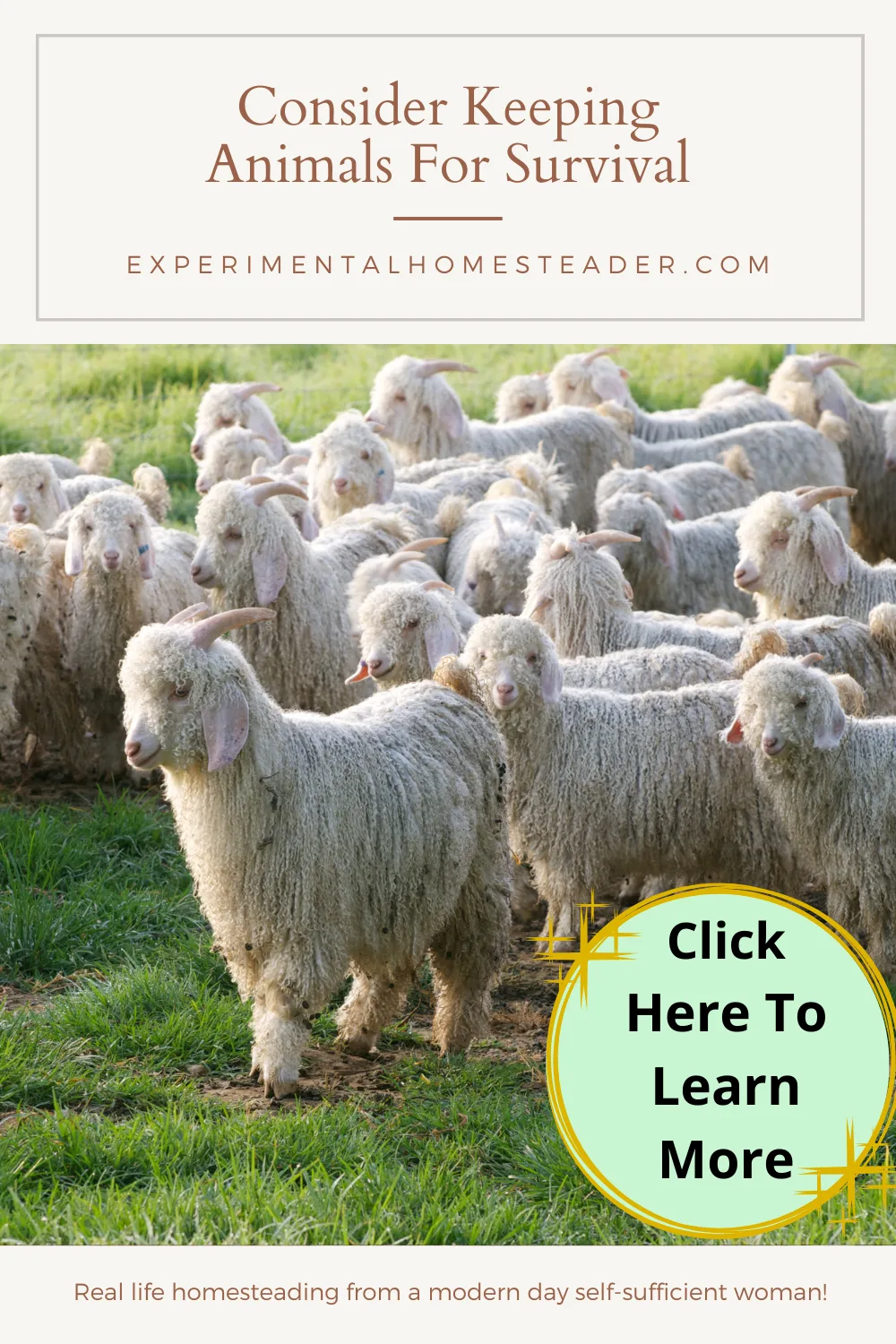
Welcome to today's podcast episode, Consider Keeping Animals For Survival.
In today's episode, we're diving deep into the realm of animal husbandry for survival, examining the hurdles faced and the unexpected rewards that come with raising animals for self-sufficiency.
Join us as we dissect the intricacies of this season's approach to animal husbandry, dissecting factors like care routines, environmental conditions, and the resulting quality of resources produced.
Come along on this journey as we uncover the challenges and victories of nurturing livestock, sharing insights on resilience and discovering the sweetness in overcoming obstacles along the path to preparedness.
📍 Hey guys, Sheri Ann Richerson from Experimental Homesteader, Exotic Gardening, sheriannricherson. com and biannualblogathonbash. com and welcome to our daily vlog. Today we're going to go back and talk about some of the survivor prepper tasks for beginners that I've been working on. There are actually 50 of these and we are up to number 17 right now.
📍 Now as I always point out when I do one of these, these tasks are not just for beginners. These are things that survivalists and preppers and homesteaders can do regardless of where in the journey you are, because we all take a slightly different journey. And some of us start with one thing, and then as we grow, we move on to other tasks.
📍 And the goal is to have all of these 50 items done, have a plan in place, so that if something happens, you're prepared. So number... 17 is to consider keeping animals for survival purposes. Now, we all know that animals can be a handy resource in the event of a survival situation. Some people don't like the idea of butchering an animal, but you don't even need to do that.
📍 If you don't want to, if the animal needs butchered, it's fairly easy if you're willing to share the meat to find somebody that will do that for you. Sometimes you can find a butcher shop that will do it and you can just pay them and all you have to do is drop the animal off. You don't even have to kill the animal at a lot of the shops.
📍 They want you to bring in the animal live. But other Things that you can do if you don't want to kill your animals. That's fine. You can keep You can have goats, milk, sheep, various animals for milk and, of course, if you've got your own source of milk, then you're going to be able to make all kinds of dairy products like cheeses - both a fast cheese that you can make and eat right away and harder cheeses or semi hard cheeses that take a while to make.
📍 To actually become the cheese that you want it to be, that does take a little bit of a controlled environment. I have used a mini refrigerator. I have used a wine cooler. It's a key is to get the temperature and the humidity right and yes, fresh cheeses that you're trying to make do end up with mold on them, but usually it's a harmless mold and you just cut it out and move on.
📍 So you can also raise animals for their wool. So if you need blankets or clothing, et cetera, you've got a source of material. Now a lot of people think about sheep when it comes to fiber animals, but they're not the only animals you can raise for fiber. You can raise angora rabbits. You literally just comb them or you can gently just kind of pull up like this on the fur.
📍 And it will come right off. It really, really doesn't hurt them and it's really good to remove that fur on a daily basis. I should say fiber, not fur. If you don't, they can lick themselves and all of that goes inside of their mouth and into their stomach and can actually kill them. So, Angora rabbits are kind of a high maintenance animal.
📍 If you've got the time to deal with them every day, and brush them, and take good care of them, that's a good choice because they're small, they're easy to manage, but they are a time hog. Other animals that you can raise for fiber include Angora goats, which give you mohair, and cashmere goats. And gore goats, like sheep, you have to shear twice a year to get the fiber off of them.
📍 They can be kind of big, especially if you get a buck. Because, you know, they have these big huge horns. And bucks are usually bigger than does anyway. You don't want to remove the horns of a fiber animal because that is actually their cooling system. And they have all of this fur and stuff on them.
📍 And if they can't cool down, they will die. We actually had a sheep that had heat stroke. We didn't remove, she was actually hornless the breed was, but she was black. She had black wool and I thought she was going to be okay because we had a shady area, but she actually ended up having heat stroke and dying.
📍 So you've got to be aware of this and you've got to be really careful if you're going to raise fiber animals. And pay attention so that these kind of things don't happen. Cashmere goats are more like angora rabbits where you can just brush them and the fiber comes right off in the spring. They kind of puff up and it looks like they're turning gray and getting really big and puffy and that's just the cashmere.
📍 Of course, Fiber animals have different, different quality of fiber. So, not all fiber animals produce a high quality micron. I believe that's what it's called. It's been a while since I've had fiber animals. You can get that tested if you just don't care. If you like the feel of... The fiber that comes off your animals, and you're just using it for yourself.
📍It's not a big deal. If you're actually going to sell that fiber, or possibly sell a product made with that fiber, like yarn, or cloth, or whatever, you may want to go ahead and do the testing. That's completely up to you, and what you feel like you need to do to, Have your business the way you want it to be.
📍So now when it comes to making the blankets and the clothing, you can make pillows with wool, you can make mattresses with wool, you just have to know how to do it. And it does take a little bit of time and a little bit of practice. But you can basically spin that fiber into yarn. This is not as easy as it looks.
📍It definitely takes practice. And then you can crochet. You can knit or you can weave. I actually like weaving better than I like crocheting or knitting. Just because I think it's easier. The one thing that you need to know about natural fibers is they will felt. So, you need to be careful when you wash it.
📍You need to do a lot of research before you get into fiber animals to make sure this is what you want to do. Make sure you have the time to deal with it. And if you don't want to send your fiber out and have it washed, processed, If you're going to do it yourself, then you need to be aware of the process.
📍Modern washing machines, you're not going to be able to wash your fiber in. That doesn't mean that you can't put it in big tubs and put it outside and just let it kind of soak and process. That way, that's a whole method and I have tried that. But I have an older washing machine, so I can fill it with the hot water.
📍And the soap, I can agitate it and then stop my machine and put my wool in and just soak it for half an hour. Spin it out. You don't want it to agitate with that wool in there, it will felt it, but I can just spin it out. And, take it out and then fill my washing machine again with hot water. Needs to be the same temperature.
📍And just soak it for another half an hour and then spin it out and let it dry. So that's the method I've always used and of course many of these animals, sheep, goats, they can be used as food as well. Now, they may not, be as fatty. I don't want to say fatty, as meaty. They may not have as much meat on them as, say, a boar goat, which is bred for meat.
📍A lot of angora goats were a fiber meat breed, so they may be okay, but the cashmere goat that I had, she was more in line with what a dairy goat is as far as size. So had we decided to eat her eventually, I don't think she would've had a lot of meat on her.
📍 But if the alternate is starving to death or eating your animals, then I'm sure you're going to consider another animal that you can raise that is fairly easy and doesn't take a whole lot of space is tilapia. Now, they do require staying warm in the wintertime or you would have to raise them starting in late spring through the summer and then go ahead and prepare them.
📍And put them in a freezer by winter time, but if you go with aquaponics and you choose fish, you can grow your vegetables right on top. So if you have very, very limited space, but you really want to raise some animals, you want to raise some vegetables, you want to kind of see how much you can provide for yourself.
📍Tilapia and a few vegetables in an aquaponic unit is a great way to go. So I hope that gives you some. So there you have it guys, some ideas on why you should consider keeping animals for survival purposes. If you have questions or comments, please leave those in the comments below. I want to thank you guys for watching, and I hope all of you have a great night.
📍And we'll see you again tomorrow on another daily vlog. Thanks for watching.
Be sure to look for the Experimental Homesteader Podcast on Apple Podcasts and also Amazon Music - and be sure to follow so you don't miss an episode!






